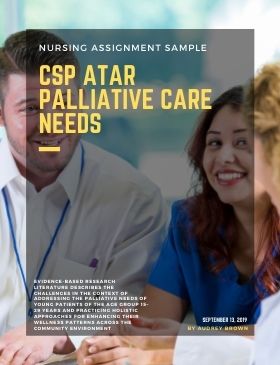You can download the sample Nursing case study on Critical review of case in Health management with the following question for free at the end of this page. For further assistance with Nursing Assignment help, please check our offerings in Nursing assignment solutions. Our subject-matter experts provide online assignment help to Nursing students from across the world and deliver plagiarism free solution with a free Turnitin report with every solution.
(AssignmentEssayHelp does not recommend anyone to use this sample as their own work
Nursing Assignment Question
Australia's population is becoming increasingly diverse. Therefore, meeting the palliative care needs of a diverse population poses many challenges. Use the life span category of Young Adult to demonstrate your understanding of a palliative care approach.
Write an essay that:
a) Discusses the importance of providing age appropriate palliative care reflecting a palliative approach for a person and their family.
b) Illustrate your understanding of nursing care using a palliative approach when applied to the life span category of Young Adult.
• Use current and relevant literature to adequately support your discussion throughout the essay.
References must be in APA style, adequately and coherently given, both in text and in the final reference list, American Psychological Association referencing style guide.
• The essay must be typed. Typing must be legible, at least 12 font, double spaced.
Nursing Assignment Solution
Evidence-based research literature describes the challenges in the context of addressing the palliative needs of young patients of the age group 15–29 years and practicing holistic approaches for enhancing their wellness patterns across the community environment (Bhatnagar & Joshi, 2011). The clinical findings reveal the emotional and social requirements of the young patients undergoing treatment for their end of their living conditions. These requirements attribute to their education, career opportunities, sexuality and marriage related matters requiring effective evidence-based nursing interventions to facilitate the quality of life and reduction in the intensity of clinical manifestations. The nurse professionals face numerous challenges in terms of recognizing the care needs of these young adults during the course of clinical interventions in the context of accomplishing their personal requirements.
Age appropriate and culturally competent palliative care interventions are required in the context of mitigating disease manifestations among individuals of various age groups (Kuebler, Davis, & Moor, 2005, p. 199). The progression of numerous chronic and life-threatening conditions influenced by the age factor and geographical constraints. Furthermore, the immunity of individuals for challenging the progression of acute symptoms of the disease varies between various age groups and therefore, palliative interventions in the context of the age of the affected individuals warranted while customizing the care strategies for patients in accordance with their personalized and age-related clinical requirements. Evidence-based literature describes the high mortality rates among patients between 0 – 19 years of age groups under the influence of congenital deformities (Knapp, et al., 2012, p. 275). Therefore, based on the age group of these congenitally deformed patients, nurse professionals require formulating assistive interventions to facilitate the accomplishment of psycho-socio-somatic requirements of the physically deformed and debilitating patients.
Nurse professionals require establishing care goals for the patients between 0 – 19 years of age in the context of enhancing their quality of life and satisfaction for the provided treatment approaches across the clinical setting. The nurses also need to collaborate with the families of young patients for understanding their psychological and spiritual requirements and for developing a shared thought process for improving the confidence levels of the young patients during the progression of their terminal conditions (Coyle & Paice, 2015, p. 1044).
Overcoming the Prognostic Paralysis
The lack of holistic approaches and palliative interventions for patients affected with life-threatening chronic conditions leads to the patterns of their mental instability and psychosocial conflicts (Murray, 2005). Prognostic paralysis attributes to the inappropriate interpretation of the feelings of patients by the medical professionals that reciprocally leads to the pattern of insecurity across the patient population. Indeed, the correct interpretation of the individual requirements, feelings, contentions, and apprehensions of patients requires active collaboration between nurse professionals and physicians with the objective of extending psychosocial support to the affected patients. The timely recognition of the patterns of clinical manifestations and disabilities of the young individuals required by the nurses and physicians for enhancing their level of comfort while implementing personalized care approaches in the context of improving the wellness outcomes. Strategic psychosocial interventions by the nurse professionals require effective implementation in the context of overcoming lack of prognostic certainty among the young patients affected with debilitating chronic conditions. The uncertainty regarding the disease outcomes in severely debilitated young patients adversely influences their pattern of hope in the context of willingness to survive in the community environment. Therefore, keeping these factors in mind, nurse professionals require configuring coping interventions for motivating the young patients in relation to enhancing their social relationships for normalizing their lives while overcoming the prognostic uncertainty of the disease conditions (Foyle, 2010, p. 197-198).
The Objectives of Palliative Care for Young Individuals
Nurse professionals require attaining thorough understanding and insight regarding the palliative care objectives for providing personalized and holistic evidence-based care interventions to the patient population. These objectives attribute to the consideration of dying as a normal physiological process even for the patients resisting the symptoms of chronic and debilitating end of the living conditions. Furthermore, care interventions focussed in effectively facilitating the dignity and comfort of the affected patients and extending psychosocial support to the family members during the phase of bereavement (McMurray & Clendon, 2015, p. 343). The preliminary objective of extending palliative care to the eligible young subjects attributes to the establishment of the sense of accomplishment and wellness while enhancing their quality of life across the community environment. The nurse professionals require exploring the cultural beliefs and contentions of the affected patients with the objective of collaborating with them during the course of their supportive interventions for acquiring the desirable wellness outcomes. The other important objective of palliative care interventions by nurses attributes to proactively planning for the prospective care of patients while discussing their end of life preferences and desires. Integrating cultural considerations of the patients and their families help in mitigating the negative perspectives of the patients in relation to enhancing their self-sufficiency while resisting challenging manifestations of the debilitating clinical conditions during the course of medical intervention. Evidence-based clinical literature describes the practice of death education in Australia in the context of extending palliative care services to eligible youngsters (Stillion & Attig, 2015, p. 230). Death education is of paramount importance in terms of preparing the patients for dealing with their end of life stage with ease and confidence.
Age Appropriate Palliative Care Nursing Interventions and Challenges for Young Australians
Evidence-based research literature advocates the contention in relation to utilizing multi-informant approaches while providing palliative care and assistance to the patient population (Issues in Disability, Rehabilitation, Wound Treatment, and Disease Management, 2012). Indeed, the enhancement of the psychological profile of the young (Australian) affected patients warrants the effective acquisition of information regarding their psychosocial profile for accomplishing the care outcomes. The subjective assessment of the patients requires face-to-face interaction with them and their families for empirically evaluating their psychological and spiritual discrepancies with the objective of devising community interventions for enhancing cognition and self-efficacy (of the affected patients). The action plan is required by nurses while attempting to provide palliative interventions to the young patients attributes to the establishment of close collaboration with them to facilitate the transit of information required for enhancing the wellness outcomes (Pfund & Fowler-Kerry, 2010, p. 125-128).
The research findings by (Grinyer, 2012) reveal the requirement of educating the medical professionals in the context of rendering psychosocial interventions rather than acute care approaches with the objective of extending the lives of the debilitating youngsters during the advanced stages of their illness. The nurse professionals require creating a balance between the therapeutic interventions and the palliative strategies while supporting the young patients affected with life-threatening chronic conditions. Coordination of care between nurses, physicians and other medical professionals highly required for effectively transferring significant medical information while shifting the patients between various inpatient wards for extending the treatment interventions. This transfer of information assists the fellow nurses and physicians in providing the desirable palliative support to the affected patients. The nurses require attaining insight regarding the physical and emotional aspects of death and disease while rendering palliative interventions to the affected young patients (Matzo & Sherman, 2015, p. 267).
Evidence-based research literature emphasizes the significance of spiritual caring in the context of providing holistic care to the patient population (Ronaldson., et al, 2012). The advanced level of palliative nursing care requires the effective incorporation of spiritual perspectives for enhancing health outcomes. However, nurse professionals require practicing time management strategies in efficiently extending the spiritual interventions for enhancing the mental and emotional health of patients affected by the terminal conditions. Nurse professionals require configuring patterns of therapeutic relationship with patients and their families in facilitating the execution of patient-centered approaches to terminally ill patients (Wittenberg, et al., 2015, p. 27). The moral practice of palliative care requires the creation of trust and empathy among hospice patients through effective communication by nurse professionals. The patterns of therapeutic communication between the nurse professionals and the terminally ill young patients help in restoring their dignity and confidence while dealing with the debilitating life-threatening conditions. Furthermore, family-centered approaches require execution by the nurse professionals for obtaining family assistance in terms of accomplishing the personal requirements of patients during the advanced stages of their chronic conditions.
Conclusion
The preliminary goal of palliative care interventions attributes to enhance the quality of life of young Australian patients affected terminal conditions with minimal chances of survival. Indeed, the consistent growth of Australia's population results in the reciprocal increase in the chronic and debilitating conditions among patients across the community environment. This has resultantly increased the scope of rendering holistic and patient-centered pediatric interventions for the patient population. The community-based interventions warranted by the nurse professionals for safeguarding the rights and dignity of the young Australian patients while addressing their psychosocial deficits, personal contentions, and care requirements across the community environment. The social and physical needs of terminally ill individuals require effective tracking for enhancing the scope of healthcare assistance in the context of alleviating the symptoms of their terminally ill conditions.
(Some parts of the solution has been blurred due to privacy protection policy)



 WhatsApp Us
WhatsApp Us